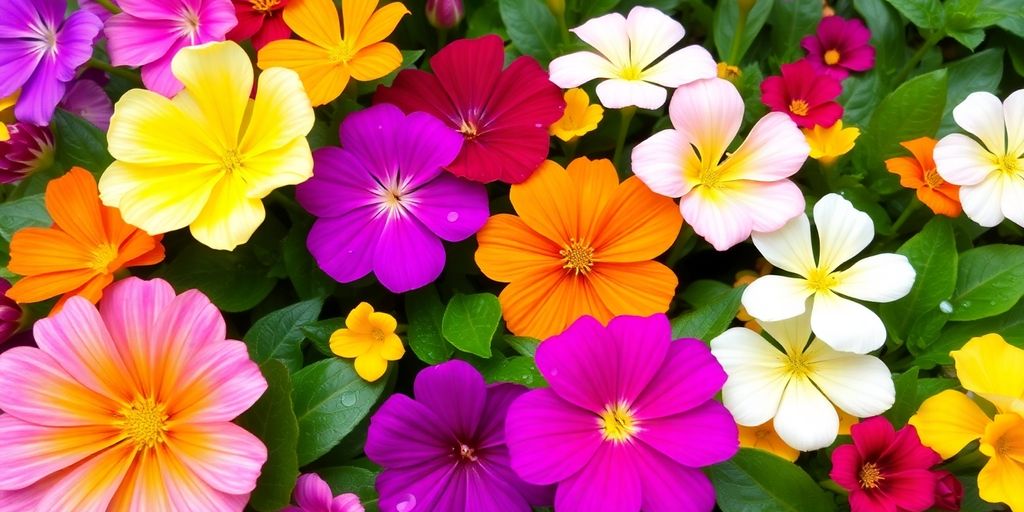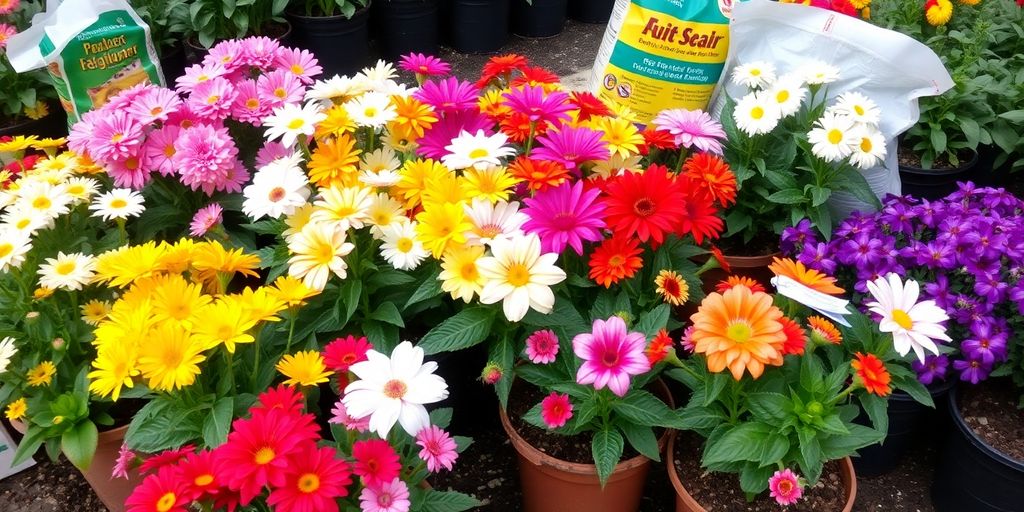Flowering plants: how to keep them blooming all year round is something every plant lover dreams of mastering. A home filled with vibrant colors and fresh blooms can lift the mood and brighten any space. With the right care, those flowers don’t have to be seasonal.
Many people think blooms are short-lived, but that’s not always true. The secret lies in understanding your plant’s needs and responding consistently. Light, water, and pruning all play a key role in long-lasting beauty.
Even the most stunning flowering plants need a bit of encouragement to thrive year-round. It’s not just about keeping them alive—it’s about helping them flourish. A little attention goes a long way toward continuous blooms.
Curious how to get started? This guide will share essential tips to help you enjoy healthy, flowering plants through every season. Let’s make those blooms a regular part of your home.
Key takeaways
- Water your plants according to their specific needs to avoid overwatering or underwatering.
- Choose the right fertilizer to provide essential nutrients, and know when to apply it for the best results.
- Ensure your flowers get the right amount of sunlight by adjusting their location as needed.
The right amount of water for thriving flowers

Understanding your plant’s water needs
Alright, so watering – it’s not rocket science, but it’s definitely an art. I’ve killed my fair share of plants by either drowning them or letting them dry out to a crisp. The key is really understanding what each plant needs.
Some are like camels and can handle dry spells, while others are thirsty divas that need constant moisture. I usually start by checking the plant tag or doing a quick search online to get a general idea. Then, I adjust based on how the plant looks and feels. It’s all about paying attention, ya know?
Signs of overwatering and underwatering
Okay, so how do you know if you’re messing up the watering game? Well, here’s what I’ve learned the hard way:
- Overwatering: Yellowing leaves are a big red flag. Also, if the soil is constantly soggy and the plant looks droopy, even though it’s wet, you’re probably overdoing it. Root rot is a real bummer, and it’s usually caused by too much water. I had a beautiful geranium that I loved, but I watered it every day, and it died. I was so sad.
- Underwatering: Brown, crispy leaves are a dead giveaway. If the soil is bone dry and the plant is wilting, it’s begging for a drink. Don’t let it get to that point! I’ve found that underwatered plants are easier to revive than overwatered ones, but still, try to stay on top of it.
- The Finger Test: Stick your finger about an inch into the soil. If it feels dry, it’s time to water. If it feels moist, hold off. This is my go-to method, and it works like a charm. It’s not perfect, but it’s a good starting point.
Here’s a little table I made to help you out:
| Symptom | Possible Cause | Action |
|---|---|---|
| Yellowing Leaves | Overwatering | Reduce watering frequency; check drainage |
| Brown, Crispy Leaves | Underwatering | Water thoroughly |
| Soggy Soil | Overwatering | Improve drainage; let soil dry out |
| Wilting | Underwatering or Overwatering | Check soil moisture; adjust accordingly |
Watering is one of those things that you get better at with practice. Don’t be discouraged if you mess up at first. Just keep learning and paying attention to your plants, and you’ll get the hang of it. Happy growing!
Choosing the best fertilizer for vibrant blooms

I’ve seen firsthand how the right fertilizer can turn a so-so flower display into something truly spectacular. It’s not just about throwing something on the soil and hoping for the best; it’s about understanding what your plants need and when they need it. Let’s get into it, shall we?
Types of fertilizers for flowering plants
Okay, so there’s a whole world of fertilizers out there, and it can be kinda confusing. Basically, you’ve got a few main types to consider:
- Granular Fertilizers: These are slow-release, so you sprinkle them around your plants, and they gradually release nutrients over time. I like these for a low-maintenance approach.
- Liquid Fertilizers: These are mixed with water and applied directly to the soil or foliage. They’re fast-acting, which is great if your plants need a quick boost. I’ve used these when my plants look a little sad and need a pick-me-up.
- Organic Fertilizers: These are made from natural sources like compost, manure, or bone meal. They’re great for improving soil health and providing a slow release of nutrients. Plus, you know, they’re good for the environment. I’m a big fan of using compost tea – it’s like a smoothie for your plants!
And then you’ve got to think about the N-P-K ratio – that’s Nitrogen (N), Phosphorus (P), and Potassium (K). These numbers tell you the percentage of each nutrient in the fertilizer.
For flowering plants, you generally want a fertilizer with a higher phosphorus number (the middle one), as phosphorus promotes bloom production. For example, a 10-30-10 fertilizer would be great for encouraging flowers.
When and how to fertilize your plants
Timing is everything, right? Here’s the lowdown on when and how to fertilize:
- At Planting: When you first plant your flowers, mix some slow-release granular fertilizer into the soil. This gives them a good start.
- During the Growing Season: For annuals, fertilize every 4-6 weeks with a balanced fertilizer. For perennials, fertilize in early spring and again after they finish blooming.
- Pay Attention to Your Plants: If your plants look pale or aren’t blooming well, they might need a little extra fertilizer. But don’t overdo it – too much fertilizer can burn the roots.
As for how to apply, always follow the instructions on the fertilizer package. Generally, you’ll either sprinkle granular fertilizer around the base of the plant or mix liquid fertilizer with water and pour it onto the soil. I always water my plants after fertilizing to help the nutrients soak in.
And remember, a little goes a long way – you can always add more later if needed. Happy growing, y’all!
Maximizing sunlight exposure for continuous blooms
Identifying sunlight requirements for different plants
Alright, let’s talk sunshine! Getting the light right is super important for keeping your flowers happy and blooming. It’s not one-size-fits-all, though. Some plants are sun-worshippers, while others prefer a bit of shade. I’ve learned this the hard way, trust me – a few crispy leaves taught me a lesson or two!
- Full Sun: Needs at least 6 hours of direct sunlight per day. Think petunias, zinnias, and sunflowers. These guys are like solar panels; they soak up all that energy.
- Partial Sun/Partial Shade: Requires 3-6 hours of direct sunlight, often in the morning with afternoon shade. Roses and some types of hydrangeas do well here. It’s like they want a tan, not a sunburn.
- Full Shade: Thrives with less than 3 hours of direct sunlight. Impatiens and begonias are good choices. These are the cool cats of the plant world, chilling in the shadows.
Adjusting light conditions for indoor and outdoor flowers
Okay, so you know what kind of light your plants need. Now, how do you actually give it to them? Indoors, it can be a bit tricky, but outdoors, you’ve got more flexibility. Here’s what I’ve found works:
- Indoor Flowers: If you’re growing indoors, think about where you put your plants. A south-facing window is usually the sunniest spot. If you don’t have enough natural light, grow lights are your best friend. I’ve used them, and they really do make a difference. Also, rotate your plants regularly so they get even exposure – nobody wants a plant with a bald spot!
- Outdoor Flowers: For outdoor plants, pay attention to how the sun moves across your yard. You might need to move potted plants around to follow the sun, or provide shade during the hottest part of the day. I’ve even used shade cloth to protect some of my more delicate flowers. And remember, reflected light from walls or fences can also affect how much sun your plants get. It’s all about finding that sweet spot. Getting the sunlight right is the key to a garden that blooms all season long.
Final thoughts on keeping your flowers blooming
In conclusion, keeping your flowering plants vibrant and blooming all year is totally doable with a little effort and the right approach. Remember to pay attention to their watering needs, choose the right fertilizers, and give them enough sunlight.
Mixing perennials and annuals can also help you enjoy a colorful garden throughout the seasons. So, whether you’re a seasoned gardener or just starting out, these tips can make a big difference. Don’t hesitate to experiment and find what works best for your plants. Happy gardening!
Frequently asked questions
How often should I water my flowering plants?
It really depends on the type of plant you have. In hot weather, you might need to water them every day. Other times, watering them twice a week could be enough.
What kind of fertilizer should I use for my flowers?
Look for fertilizers that have the right nutrients for your plants. For example, some fertilizers have more phosphorus and potassium, which help flowers grow better.
How can I tell if my flowers are getting enough sunlight?
Check how your plants are doing. If they look weak or aren’t blooming, they might not be getting enough light. Some plants need a lot of sun, while others only need a few hours.
